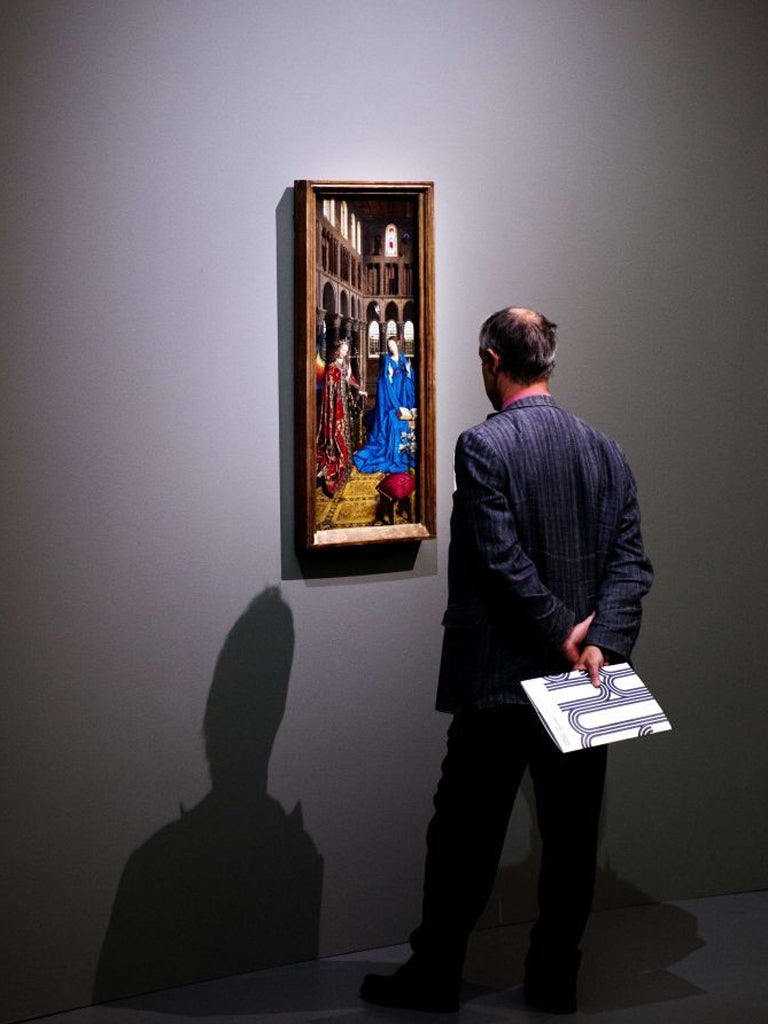The Road to Van Eyck, Museum Boijmans Van Beuningen, Rotterdam
Don't miss this stupendous display of the works of a Flemish master who, at a stroke, invented oil painting and changed the course of art history

As demands on curators go, the one made of Friso Lammertse was a cracker. "In 2008, the director asked me to prove that Jan van Eyck did not come to Earth by UFO," beams the man behind The Road to Van Eyck, a stupendous new show, four years in the making, at Rotterdam's Boijmans Van Beuningen Museum.
Lammertse's boss hadn't been reading Chariots of the Gods, but Vasari's Lives of the Artists. In his essay on the Sicilian painter Antonello da Messina, Vasari says that Van Eyck, tired of his wood panels splitting from water-based tempera, had cooked up an alternative medium of boiled linseed juice and nuts. This he mixed with his pigments. Bingo: oil painting.
Oils allow for a far freer working method than tempera, which is hard to alter once it has dried. They also have a transparency and luminosity that opaque egg paints do not. According to Vasari, Antonello, spotting these qualities in a Van Eyck altarpiece in Milan around 1450, took himself off to Bruges to learn the Flemish master's method. The rest, as they say, is art history.
As often with Lives of the Artists, this story – one man invents one thing and changes the world – seems suspiciously neat. There are fewer than a dozen works signed and dated by Jan, and about the same number again of unsigned works thought to be by him and/or his brother, Hubert. We do not know who taught the pair to paint, and the work of the names floated – Robert Campin's, for example – lacks the experimental genius of the frères Van Eyck.
Just to compound the problem, very few pre-Eyckian works – that is, panel paintings made in the Netherlands before 1430 – have survived: around two dozen in all. Jan van Eyck isn't only credited with inventing oil paint, but with using it to create something entirely new: a naturalistic, Northern European light that focuses on the minutiae of the surfaces it strikes. You can see it in spades in the National Gallery's Arnolfini Portrait. That light, too, Antonello took back with him to Italy.
The problem is that there is next to no evidence to prove or disprove Vasari's story – to argue either that other Netherlandish artists were painting like Jan before Jan did, or that his was the sole eureka moment. So Lammertse and a pair of German colleagues set out to do two things. First, they tracked down every known pre-Eyckian Netherlandish panel painting, reasoning that in these might lie a genius that at least influenced Van Eyck's. In the process, the trio added five works to the pre-existing list of 25 – the equivalent, pro rata, of turning up 100 new Rembrandts. Some, such as a set of small altarpieces, once thought to have been made by Baltic nuns, are included in the Boijmans show.
Alongside these are previously known works, some of startling loveliness. Among them is the museum's own Norfolk Triptych of 1415-20, a small but gem-like altarpiece. Even with Lammertse's Netherlandish discoveries, less than 1 per cent of panel works from before 1430 has survived, so the chances of Jan having seen any of the ones in this show is tiny. If he did, though, then it might well have been the Norfolk Triptych, made in nearby Liège and of a quality that would almost certainly have made it famous among painters.
Various hands have been suggested for the triptych, including the Van Eycks' own. The clarity of light seems Eyckian, as does the playfulness of the images on the central panel. The architectural surrounds are part of both the work's wooden frame and of the rooms in which the saints sit, occupying that same middle-world we see in the mirror of the Arnolfini portrait. But there is something annoyingly un-Eyckian about the Norfolk Triptych. Its clear, northern light casts no shadows, and the cast shadow was one of Jan's most famous innovations.
Like Rubens after him, Jan van Eyck was a polymath – painter, courtier, alchemist and spy. As an artist, his work covered all the bases. He illuminated a Book of Hours for Jean, Duc de Berry (its two surviving pages are here), he decorated polychrome sculptures, made altarpieces and portraits. Examples of all these are in the show, both by Jan and by his contemporaries.
It is clear that there are some minor overlaps between these two sets of work. The marbling on the back of Van Eyck's portrait of his wife has long been thought of as his own invention, although it is here for all to see on a Netherlandish panel made 30 years before. But these are mere details compared with the obvious differences between Van Eyck's art and everyone else's. For all Lammertse's hard work, the only rational explanation for Jan remains arrival on Earth by spaceship. Shows of this brilliance do not come along twice in a lifetime, and Rotterdam really is not far away. Swim there if you have to.
To 10 Feb (www.boijmans.nl)
Critic's Choice
One material, many wondrous uses: Bronze shines brightly at the Royal Academy in London until 9 Dec, showcasing the various ways the versatile alloy has been used in art in both the past and present. And that metal is the main event in Salisbury too, with Keith Coventry's Black Bronze, White Slaves at the New Art Centre. Coventry casts the detritus of modern urban life – everything from kebab machines to crack pipes – in bronze (till 18 Nov).
Join our commenting forum
Join thought-provoking conversations, follow other Independent readers and see their replies
Comments